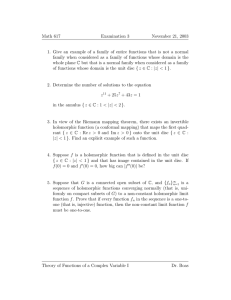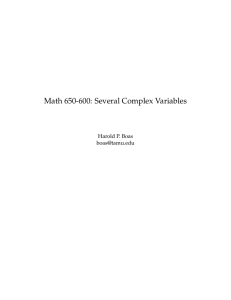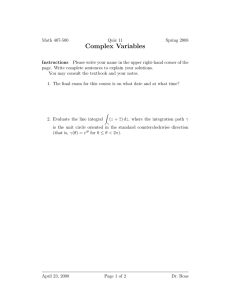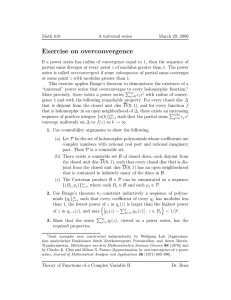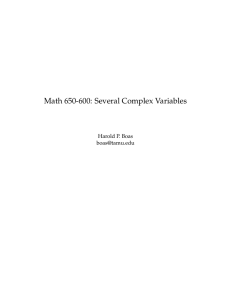Math 650-600: Several Complex Variables Harold P. Boas
advertisement
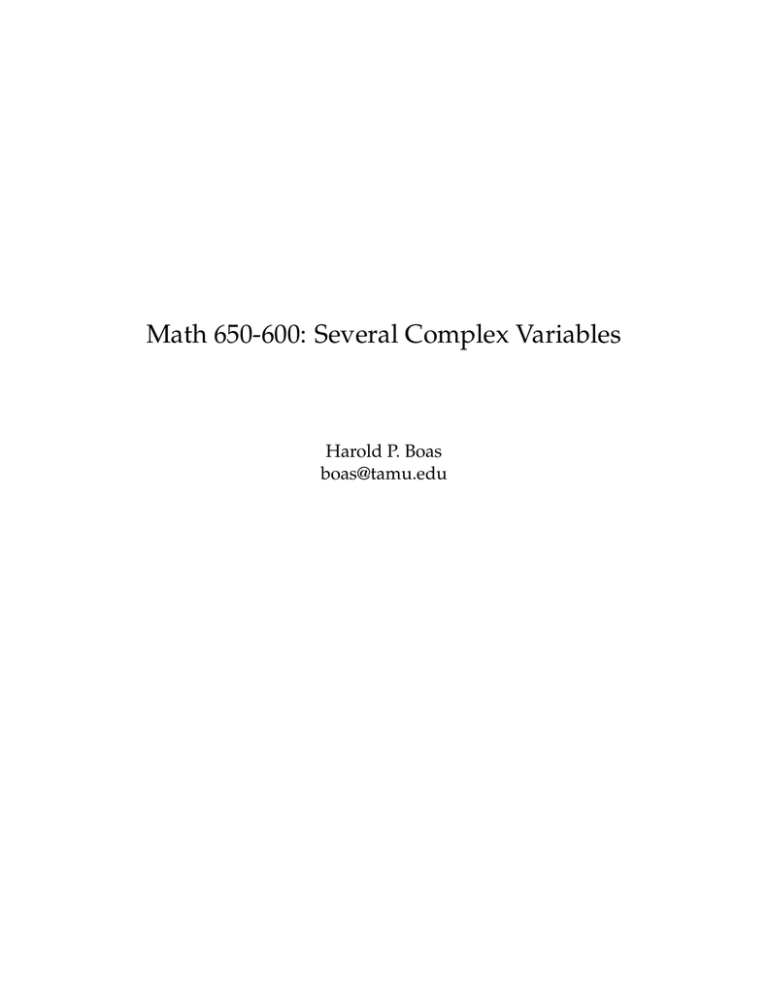
Math 650-600: Several Complex Variables
Harold P. Boas
boas@tamu.edu
Plurisubharmonic functions: reminders
A continuous (or upper semi-continuous) function u on a domain Ω in C n is plurisubharmonic if
either of the following properties holds.
1. The restriction of u to every complex line is subharmonic: namely, for every point a in Ω and
every direction b the function λ 7→ u(a + bλ) of the complex variable λ is subharmonic (where
defined).
2. The n × n Hermitian matrix
∂2 u
is positive semi-definite:
∂z j ∂zk
vectors t in Cn .
(If u is not class C 2 , one can say that i∂∂u is a positive current.)
Math 650-600
n
n
∂2 u
∑ ∑ ∂z j ∂zk t j tk
≥ 0 for all
j=1 k=1
March 22, 2005 — slide #2
Pseudoconvexity
Theorem/definition. The following properties of a domain Ω in C n are equivalent. A domain
satisfying these properties is called pseudoconvex.
1. The domain Ω is convex with respect to the set of plurisubharmonic functions.
2. The function z 7→ − log dist(z, bΩ) is plurisubharmonic.
3. There exists a continuous plurisubharmonic function u such that for every real number r,
the sub-level set { z ∈ Ω : u(z) < r } is relatively compact in Ω.
(Such a function is a plurisubharmonic exhaustion function.)
Example. If Ω is the unit ball, then − log dist(z, bΩ) = − log(1 − |z|), and this function is a
plurisubharmonic exhaustion function.
Math 650-600
March 22, 2005 — slide #3
The Levi problem
Every domain of holomorphy is pseudoconvex because the hull with respect to the plurisubharmonic functions is contained in the hull with respect to the moduli of holomorphic functions.
E. E. Levi’s problem.
Prove the converse: every pseudoconvex domain is a domain of holomorphy.
Eugenio Elia Levi
We will solve the problem later using ∂ methods.
(1883–1917)
Math 650-600
March 22, 2005 — slide #4
Proof of pseudoconvexity equivalents
1. Ω is convex with respect to plurisubharmonic functions.
2. z 7→ − log dist(z, bΩ) is plurisubharmonic.
3. A continuous plurisubharmonic exhaustion function exists.
(2) ⇒ (3).
− log dist(z, bΩ) is an exhaustion function if Ω is bounded.
In general, use max(|z|2 , − log dist(z, bΩ)).
(3) ⇒ (1).
If K ⊂⊂ Ω, then K is contained in some sublevel set of the plurisubharmonic exhaustion funcb is contained in the same sublevel set.
tion. By definition of hull, the plurisubharmonic hull K
b ⊂⊂ Ω.
Therefore K
It remains to prove that (1) ⇒ (2).
The proof uses the Kontinuitätssatz of Hartogs.
Math 650-600
March 22, 2005 — slide #5
Analytic discs
Definition. An analytic disc in Cn is the image of a map ( f 1 , . . . , f n ) of a closed disc in C, where
each component function f j is holomorphic on the open disc and continuous on the closed disc.
The boundary of an analytic disc means the image of the boundary of the one-dimensional disc.
Theorem. If Ω is convex with respect to the plurisubharmonic functions, then Ω satisfies the
continuitySprinciple (Kontinuit
Sätssatz): namely, if {Dα } is a collection of analytic discs in Ω
such that α bDα ⊂⊂ Ω, then α Dα ⊂⊂ Ω.
Proof. By the maximum principle for subharmonic functions,
S each D α is a subset of the
plurisubharmonic hull of bDα. The plurisubharmonic hull of α bDα is relatively compact by
the hypothesis of plurisubharmonic convexity.
Math 650-600
March 22, 2005 — slide #6
Exercises
1. Verify that if u is a plurisubharmonic function of class C 2 on a domain Ω, and if F : G → Ω
is a holomorphic mapping, then u ◦ F is a plurisubharmonic function on G.
The domains G and Ω may be in spaces of different dimensions.
2. By convolving with a mollifier, show that if u is an arbitrary plurisubharmonic function (not
necessarily smooth), then u is the limit of a decreasing sequence of smooth plurisubharmonic
functions.
More precisely, if u lives on Ω, then there is an exhaustion of Ω by nested subdomains Ω j , and
there is a smooth plurisubharmonic function u j on Ω j such that the sequence u j ↓ u.
Math 650-600
March 22, 2005 — slide #7

